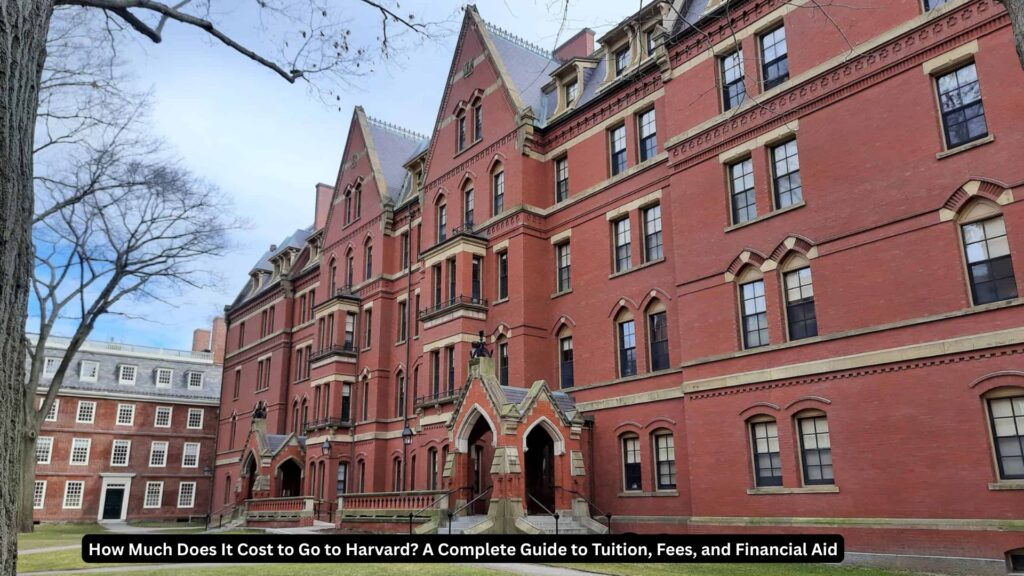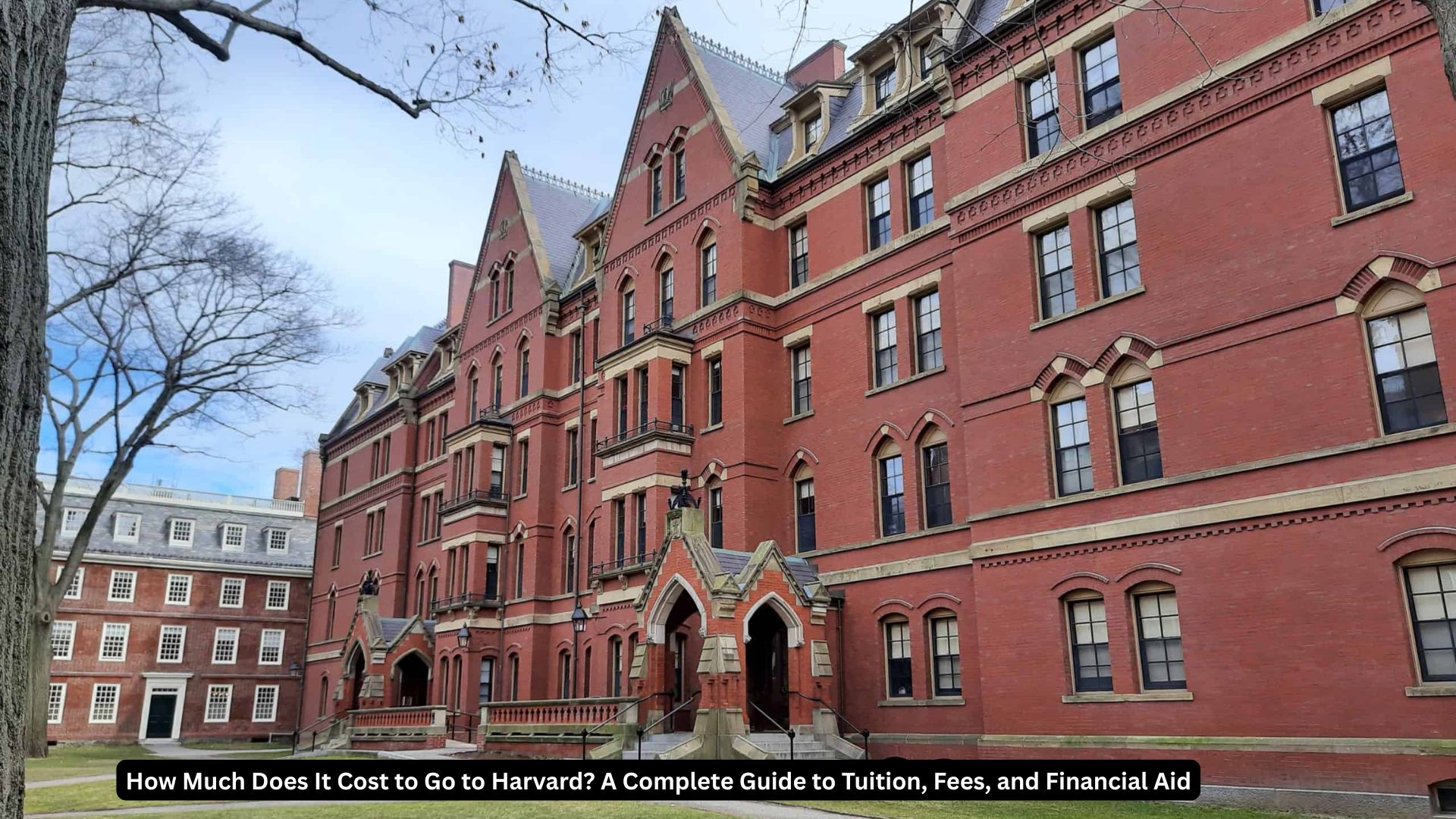How Much Does It Cost to Go to Harvard? Harvard University—one of the world’s most prestigious institutions—has long been associated with academic excellence, groundbreaking research, and a legacy that spans centuries. However, when students and parents begin to consider applying to Harvard, one of the most common questions that arises is: “How much does it cost to go to Harvard?”
This question isn’t just about tuition. The true cost of attending Harvard includes tuition, housing, dining, books, personal expenses, and travel. While the total price tag may seem intimidating, Harvard’s need-based financial aid program ensures that students from all economic backgrounds have access to its education.

In this article, we will explore Harvard’s tuition costs, the breakdown of student expenses, how financial aid works, and why the university remains an accessible option for talented students around the globe.
Understanding Harvard’s Cost of Attendance
When discussing the cost of attending Harvard, it is essential to understand the term “Cost of Attendance (COA)”. COA refers to the estimated total expenses for one academic year and includes:
- Tuition and Fees
- Housing and Food (Room and Board)
- Books and Supplies
- Personal Expenses
- Travel Costs
For undergraduate students, Harvard publishes this information annually. The total cost reflects both direct expenses (billed by the university) and indirect costs (like travel or personal spending).
Tuition and Fees for 2025–2026 (Estimated)
For the academic year 2025–2026, the estimated cost of attendance for a Harvard College undergraduate student is approximately $82,950 per year. This includes all major expenses for a single academic year (nine months).
Breakdown of Estimated Costs
| Expense Category | Estimated Annual Cost (2025–2026) |
|---|---|
| Tuition | $58,400 |
| Student Fees | $5,100 |
| Room (Housing) | $12,600 |
| Board (Meals) | $8,000 |
| Books and Supplies | $1,000 |
| Personal Expenses | $2,800 |
| Travel | $1,000–$4,000 (varies by location) |
| Total Estimated Cost | $82,950 (approx.) |
These figures represent the gross cost—what a student would pay if they received no financial aid. However, most students do not pay the full amount. In fact, over 50% of Harvard undergraduates receive need-based aid.
Graduate School Costs
Graduate tuition varies widely across Harvard’s schools. Each of Harvard’s 12 graduate and professional schools sets its own tuition rates, depending on the program and duration.
Examples of Graduate Tuition (Per Year)
| School | Program | Approximate Annual Tuition (USD) |
|---|---|---|
| Harvard Business School | MBA Program | $76,000 |
| Harvard Law School | JD Program | $74,200 |
| Harvard Kennedy School | MPP / MPA Programs | $60,000 |
| Harvard Graduate School of Education | Master’s Programs | $55,000 |
| Harvard Medical School | MD Program | $70,000 |
| Harvard Divinity School | Theological Studies | $46,000 |
| Harvard T.H. Chan School of Public Health | MPH / MS | $58,000 |
These costs typically exclude housing, food, and additional fees, which can add $20,000–$30,000 to the total yearly cost depending on lifestyle and location.
Financial Aid: Making Harvard Affordable
Despite the high sticker price, Harvard has one of the most generous financial aid programs in the world. The university’s goal is to ensure that admission is based on merit, not money.
Harvard’s financial aid is need-based only, meaning it depends entirely on a student’s family financial circumstances—not academic or athletic performance.
Key Features of Harvard’s Financial Aid:
- 100% of demonstrated financial need is met.
- No loans are required. Aid is given as grants or scholarships, not debt.
- Families earning under $85,000 per year typically pay nothing toward tuition, room, or board.
- Families earning between $85,000 and $150,000 pay 10% or less of their income.
- Over 20% of Harvard families pay nothing at all.
Example of Financial Aid in Action
| Family Income Level | Expected Annual Contribution | Estimated Annual Cost After Aid |
|---|---|---|
| $65,000 | $0 | $0 |
| $100,000 | $7,000 | $7,000 |
| $150,000 | $15,000 | $15,000 |
| $250,000+ | Determined case-by-case | Varies |
This structure ensures that even students from moderate- or low-income backgrounds can attend Harvard without incurring crippling debt.
Scholarships and Grants
Harvard provides need-based scholarships from its own endowment, federal sources, and alumni donations. The average grant for students receiving aid is about $60,000 per year.
Sources of Aid Include:
- Harvard College Fund
- Endowed Scholarships
- Federal Pell Grants
- Supplemental Educational Opportunity Grants (SEOG)
- State Grants (where applicable)
Unlike loans, these grants do not need to be repaid.
Other Costs to Consider
While tuition and room and board make up the largest portion of expenses, there are additional costs students should plan for:
a. Books and Supplies
Textbooks and academic materials can cost around $1,000 per year, though digital materials and used books can reduce this amount.
b. Health Insurance
Harvard requires students to carry health insurance. The Harvard University Student Health Program (HUSHP) costs approximately $4,500–$5,000 per year, though this may be waived if the student already has comparable coverage.
c. Personal and Travel Expenses
Personal spending habits and travel home for breaks vary widely. Domestic students might spend $1,000–$2,000 on travel annually, while international students may spend more depending on flight costs.
d. Technology
A reliable laptop and related accessories are necessary. Many students spend between $1,000–$2,000 on technology setup during their first year.
Comparison: Harvard vs. Other Ivy League Costs
Harvard’s tuition may seem expensive, but it is comparable to other Ivy League universities. The key difference lies in Harvard’s financial aid generosity.
| University | Total Cost (Approx.) | Average Aid Package |
|---|---|---|
| Harvard University | $82,950 | $60,000+ |
| Yale University | $83,880 | $57,000 |
| Princeton University | $80,940 | $61,000 |
| Columbia University | $85,500 | $56,000 |
| University of Pennsylvania | $84,500 | $54,000 |
Harvard consistently ranks among the most affordable Ivy League schools for students receiving financial aid.
Harvard’s “No Loan” Policy
Harvard’s aid packages are designed to prevent students from graduating with debt. Instead of offering student loans, the university provides grants and work-study opportunities.
Students may choose to work part-time on campus (typically 10–12 hours per week), but this is optional, not mandatory. The goal is to allow students to focus on learning rather than worrying about finances.
International Student Costs and Aid
Harvard offers the same financial aid policy to international students as it does to U.S. students. This means international applicants are eligible for full need-based aid and receive funding packages without loans.
International students are evaluated based on their family income and resources, similar to domestic applicants.
Additionally, the Office of Financial Aid assists international students in understanding visa-related expenses, travel, and living costs.
Hidden or Optional Costs
There are a few optional expenses that some students may encounter:
- Study abroad programs (costs vary depending on destination)
- Club fees or sports team participation
- Winter and summer housing (if staying during breaks)
- Graduation fees and regalia
These are not mandatory but may add to the total yearly cost for some students.
Tips for Managing Costs at Harvard
- Apply for Financial Aid Early: Ensure all required documents (FAFSA, CSS Profile, tax returns) are submitted on time.
- Explore External Scholarships: Many organizations offer scholarships for Harvard students.
- Budget Wisely: Track personal expenses and consider cost-saving habits, such as shared meals or used books.
- Take Advantage of Campus Resources: Many events, museums, and activities on campus are free for students.
- Use Work-Study Opportunities: Campus jobs offer flexible schedules and help cover personal expenses.
Cost of Living in Cambridge, Massachusetts
Cambridge, where Harvard is located, is known for its high cost of living compared to other U.S. college towns. However, students living on campus have most expenses covered in the university’s room and board plan.
Off-campus housing can range from $1,500–$2,500 per month, depending on location and amenities. Many graduate students and postdocs choose to share apartments to reduce costs.
Groceries, transportation, and entertainment also vary, but Harvard’s meal plans and free campus activities help reduce overall living expenses.
Long-Term Value of a Harvard Education
While the upfront cost of attending Harvard is high, the long-term return on investment (ROI) is substantial. Harvard graduates often secure positions in top global companies, academic institutions, and leadership roles.
The average early-career salary for Harvard alumni is approximately $90,000 per year, and mid-career earnings can exceed $180,000 annually.
Moreover, the Harvard alumni network—spanning over 400,000 members worldwide—provides lifelong opportunities for mentorship and career advancement.
Important Links and Information
| Category | Details / Links |
|---|---|
| University Name | Harvard University |
| Location | Cambridge, Massachusetts, USA |
| Undergraduate Tuition (2025–26) | $58,400 |
| Estimated Total Cost | $82,950 per year |
| Average Financial Aid Grant | $60,000+ |
| Families Paying $0 | Those earning below $85,000 |
| Financial Aid Office | https://college.harvard.edu/financial-aid |
| Tuition and Fees Information | https://college.harvard.edu/admissions/tuition-aid |
| Graduate School Costs | https://www.harvard.edu/schools/ |
| Official Website | https://www.harvard.edu |
FAQ about How Much Does It Cost to Go to Harvard?
How much does it cost to attend Harvard for one year?
For the 2025–2026 academic year, the total estimated cost for an undergraduate student is about $82,950, including tuition, fees, housing, meals, and other expenses.
Do students actually pay the full amount?
No. More than half of Harvard undergraduates receive need-based financial aid. Most families pay significantly less than the full price.
Can middle-class families afford Harvard?
Yes. Families earning between $85,000 and $150,000 typically pay 10% or less of their income toward the total cost.
Does Harvard offer scholarships or only need-based aid?
Harvard offers need-based aid only. There are no merit-based or athletic scholarships.
What is the average financial aid package?
The average aid package is around $60,000 per year, reducing the net cost for most students to a manageable amount.
Do international students receive financial aid?
Yes. International students are eligible for the same need-based aid as U.S. students, and Harvard meets 100% of demonstrated need.
Are there loans in Harvard’s financial aid package?
No. Harvard follows a “no-loan” policy—aid is provided as grants, not loans.
How do I apply for financial aid?
Students must submit the CSS Profile, FAFSA (for U.S. students), and supporting documents such as tax returns through Harvard’s financial aid portal.
What about graduate student aid?
Graduate students may receive fellowships, research assistantships, or departmental grants depending on the program.
Is Harvard worth the cost?
Yes. Considering Harvard’s financial aid policies, academic reputation, and career outcomes, it offers one of the highest returns on educational investment worldwide.
Conclusion
The cost of attending Harvard University may appear high at first glance, but the reality is far more encouraging. With one of the most generous financial aid programs in the world, Harvard ensures that financial circumstances never become a barrier to accessing world-class education.
From tuition and housing to books and meals, the total annual cost can exceed $80,000—but few students pay the full amount. In fact, thousands attend Harvard for little to no cost thanks to need-based aid and scholarship grants.
Ultimately, Harvard’s commitment to affordability, combined with its academic excellence, global network, and lifelong value, makes it not just a university—but an investment in a future of opportunity and achievement.

